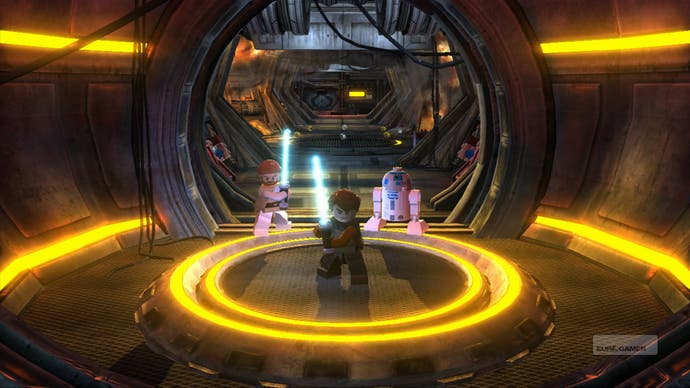LEGO Star Wars III: The Clone Wars
Not just another brick in the wall.
There's a popular misconception that the LEGO series never changes; that every game is a shameless repeat of the first with different LEGO versions of licensed characters swapped around for each money-grabbing iteration.
If you're just glancing at the games from afar, it's easy to make this assumption. Tiny figures run and jump around brightly coloured maps, smashing everything in sight and slurping up hundreds of tinkling LEGO studs.
That's the heart of the series, the comforting familiar centre that kids respond to. It's as much a part of this game as the timeworn cliches of headshots, drifting and combo-punching are to other console lineages. That part, certainly, has changed very little.
Yet any parent who has sat down with their kids over the last five years or so and spent hours tracking down every last minikit (indeed, any parent who knows what a minikit is) will know that each LEGO title has its own flavour.
Features come and go from title to title, old ideas giving way to new before returning in improved forms - but the series has arguably shown more willingness to evolve over the years than many hardcore-approved titles.
When it comes to LEGO Star Wars III, even the most vehement detractor won't fail to notice the changes made to the formula. With the Clone Wars as its backdrop, LEGO has suddenly turned RTS.
Well, almost.

It's not as if the old explore-and-smash template has been abandoned completely. You still work your way through story levels using multiple characters, their complementary skills allowing you to solve gentle environmental puzzles and destroy anything that looks fragile to harvest the game's stud currency.
And you still come back later, once you've unlocked more characters, to find even more areas and extras that were inaccessible first time around. The vehicle sections remain too; you swoop around in a variety of spacecraft, blasting targets.
Red power bricks still unlock cheats and silly features. Each level still contains ten hidden minikit pieces which combine to form a collectible model. It's as familiar and exciting as a childhood Christmas morning.
Yet even here, in the meat and potatoes LEGO game material, changes have been made. The story levels can now actually tell a story, rather than plonking popular characters in recognisable locations and funnelling them to the end.
Events are more fluid, with the established gameplay styles free to flow into one another instead of being segregated into standalone levels. You can start in a deep space combat situation, then land your ship and switch instantly to controlling the characters on the ground. Those characters might then get separated, and you're able to swap between the two groups as they tackle different objectives.
Then you might switch to an entirely new character as they enter the fray. At one point you can alternate between a character trapped underground and another character circling in a dropship, using a mounted turret to clear the debris from above.

It's a shrewd decision, and one that keeps even these traditional stages feeling fresh and unpredictable. A sprinkling of new abilities and features also helps in this regard.
Jedi can use their lightsabers to carve holes in walls and doors or clear space with a Force Push. Clone Commanders can take charge of squads of troopers and direct them to attack a target.
Weaponry, too, has been given a makeover. Chainguns join rocket launchers at the heavy end of the arsenal, used to overheat golden LEGO objects until they explode. There are even sniper rifles, wielded by bounty hunters. Using these calls up a floating zoomed crosshair which depicts distant details in a pleasingly chunky 8-bit style.
Firing up the charming but basic original LEGO Star Wars as a comparison, the difference is immense. The sheer range of interactions now on offer is intoxicating to eager young brains.
When it comes to the visuals, things have taken another step forward. This is, by far, the best looking LEGO game yet. The game finally looks like it belongs in the HD era, abandoning the flat plastic look of old in favour of convincingly lit figures in more realistic locations.
One stage, which takes you into a dusty tomb illuminated only by Clone Trooper helmet lights and the glow of a lightsaber, is as atmospheric as any survival horror game.








